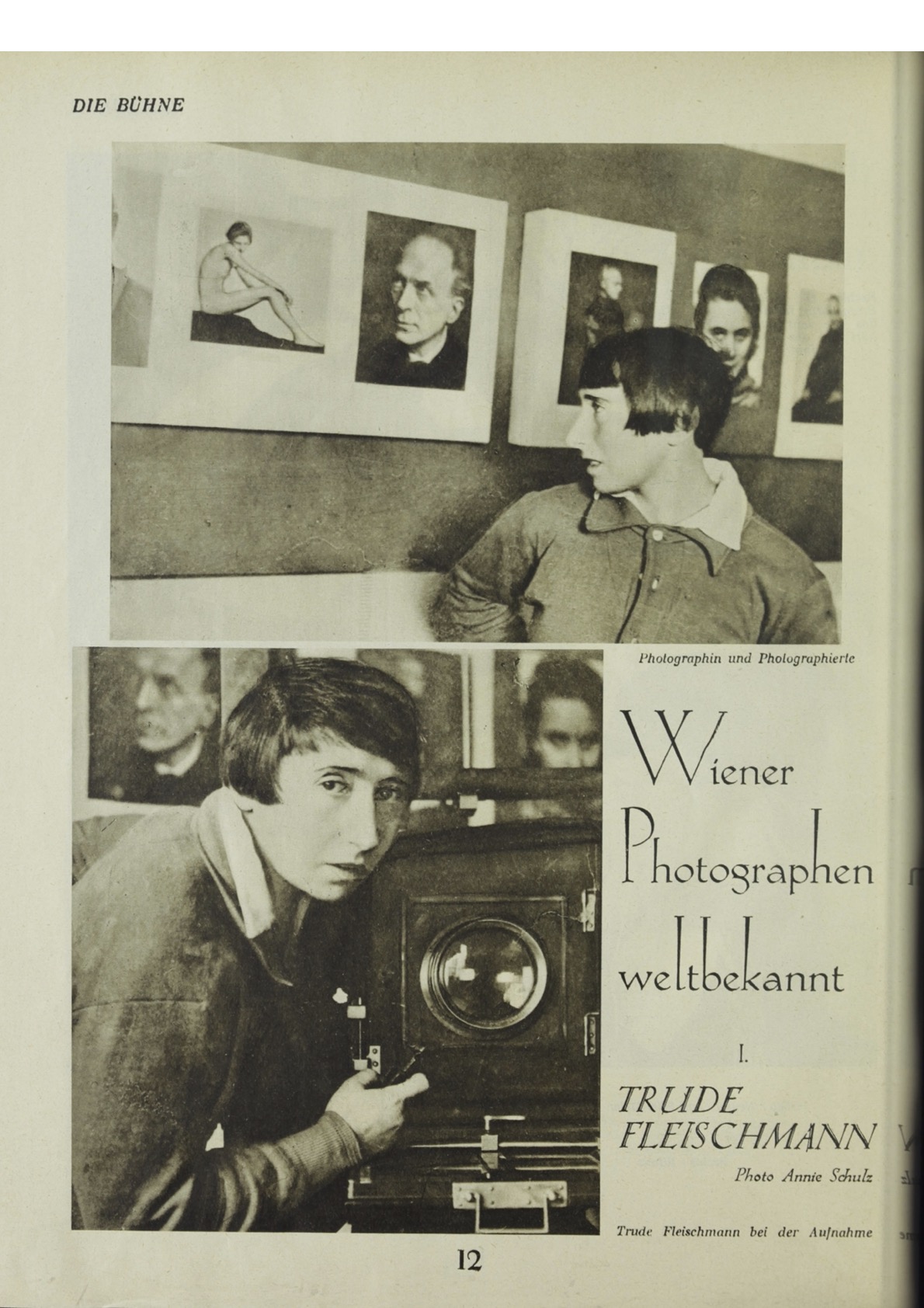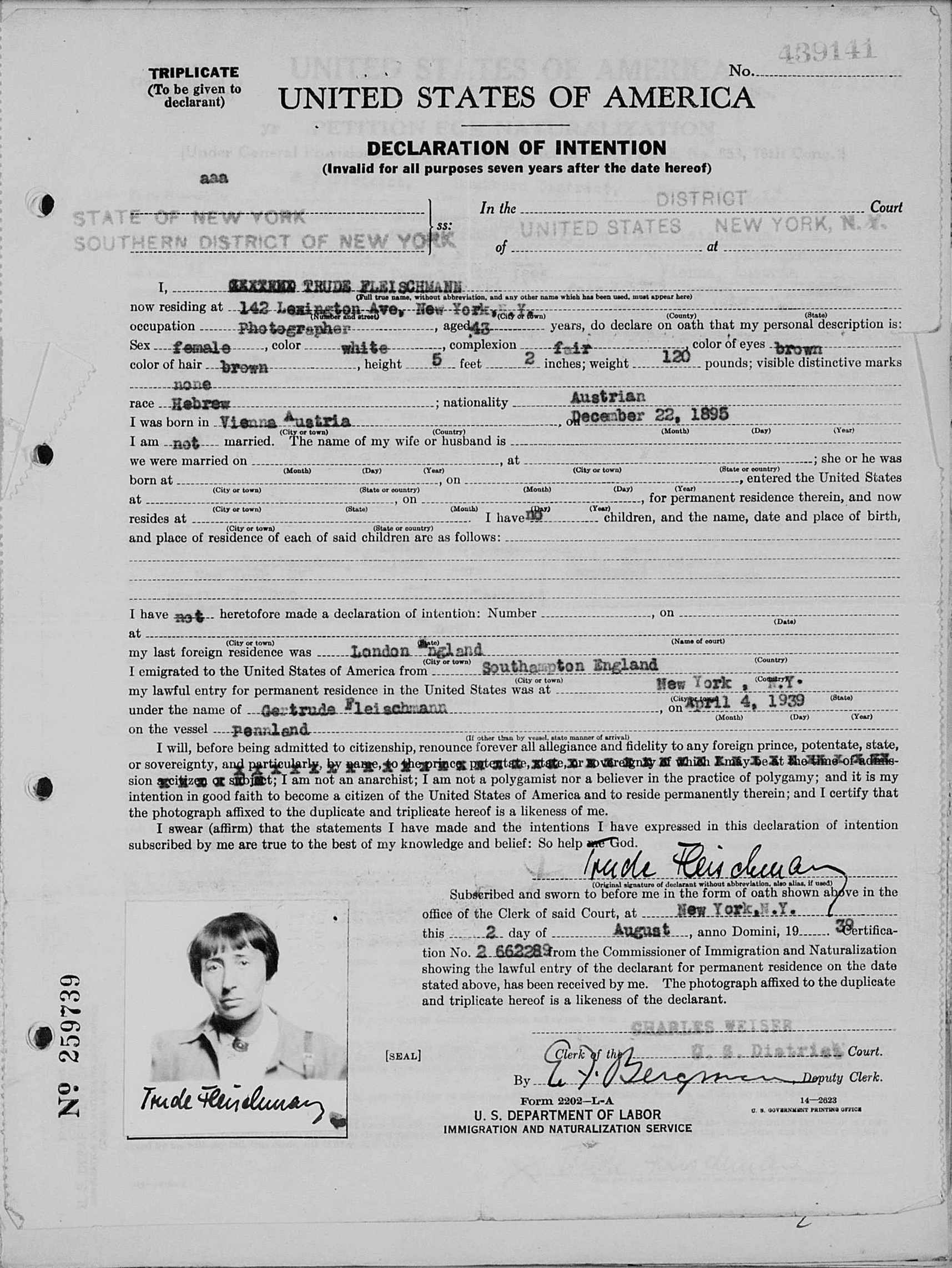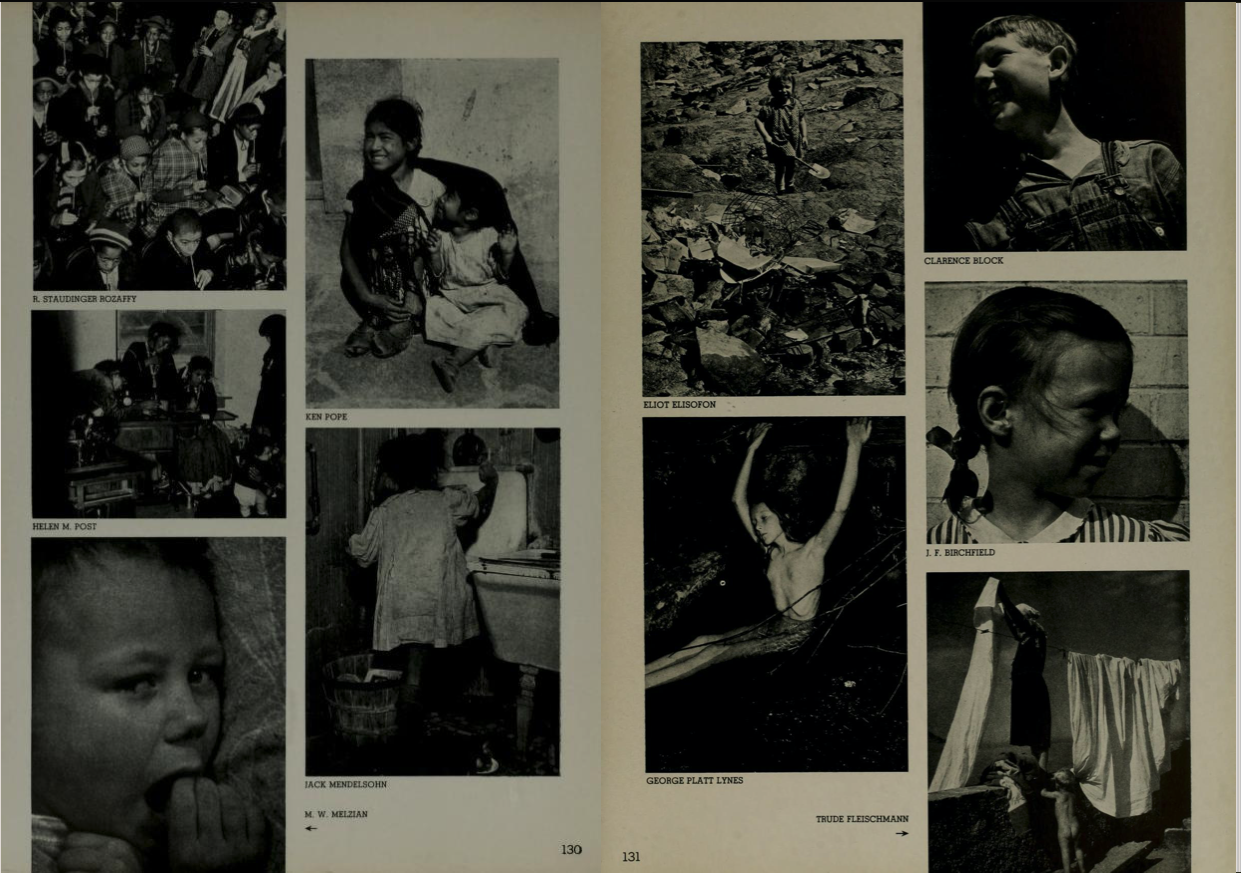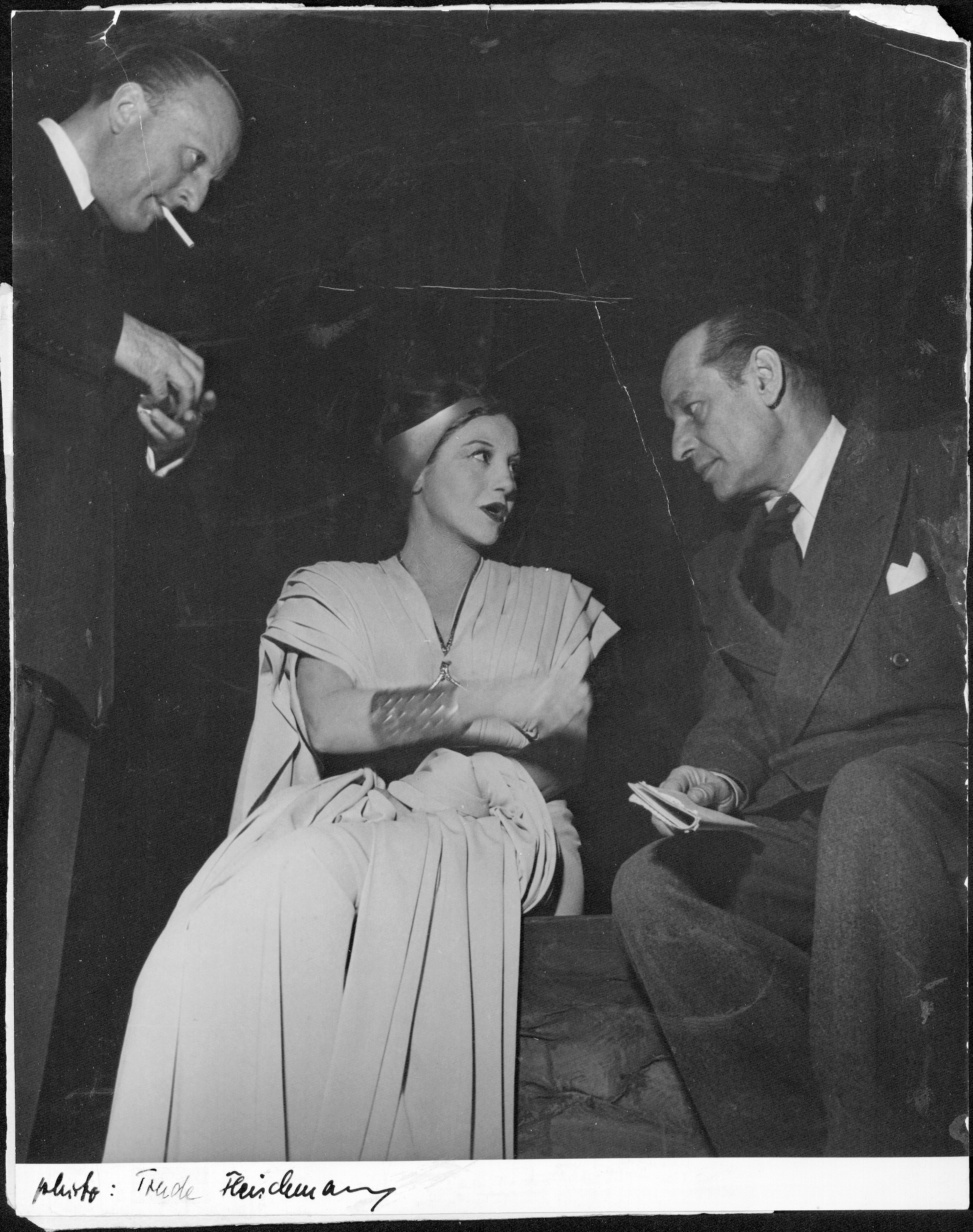Archive
Trude Fleischmann
- Trude
- Fleischmann
Gertrude Fleischmann
- 22-12-1895
- Vienna (AT)
- 21-01-1990
- Brewster (US)
- Photographer
Trude Fleischmann was an Austrian-Jewish portrait and dance photographer who emigrated in 1939 to New York, where she opened a studio in Midtown Manhattan with the photographer Frank Elmer.
Word Count: 28

Portrait of Trude Fleischmann by Annie Schulz published in Die Bühne, vol. 265, January 1931, p. 15 (Photo: Helene Roth). 
Declaration of intention of Trude Fleischmann, April 1939. New York, Southern District, U.S District Court Naturalization Records, 1824–1946, Petitions for naturalization and petition evidence 1944 box 927, no 485551-485750 (© Southern District of New York Petitions for Naturalization, 1897-1944. Records of District Courts of the United States, 1685–2009, RG 21. National Archives at New York). 
Trude Fleischmann, Adriadic Wash Line, before 1939 published in U.S. Camera 1940, p. 131 (Photo: Helene Roth). 
Trude Fleischmann, Arthur Toscanini und Robert Haas, 1946, New York (© Wien Museum / Foto Birgit und Peter Kainz). 
Trude Fleischmann, Robert Haas bei der Arbeit in New York City, 1940s/1950s (© Wien Museum / Foto Birgit und Peter Kainz). 
Trude Fleischmann, Group portrait behind the scene of “Players from Abroad”, New York, 1947/48 (© Deutsche Nationalbibliothek. Deutsches Exilarchiv 1933-1945, Frankfurt am Main). 
Announcement of an exhibition by Trude Fleischmann at the New School for Social Research published in New School Bulletin, no. 13, 13 April 1943 (© New School course catalog collection, NS-03-01-02. The New School Archives). 
Trude Fleischmann, Portrait of Gert von Gontard, Elisabeth Bergner and Felix Gerstmann for the performance Iphigenie auf Tauris,New York, 1947/48 (© Deutsche Nationalbibliothek. Deutsches Exilarchiv 1933-1945, Frankfurt am Main). Auer, Anna. Fotografie im Gespräch. Klinger, 2001.
Displaced Visions. Émigré Photographers of the 20th Century, edited by Nissan N. Perez, exh. cat. The Israel Museum, Jerusalem, 2013.
Gilbert, George. The Illustrated Worldwide Who’s Who of Jews in Photography. G. Gilbert, 1996.
Holzer, Anton. "Exilfotografien, wiederentdeckt: Der Schatz der Trude Fleischmann." Die Presse, 11 July 2020. Accessed 23 April 2021.
Krohn, Claus-Dieter, et al., editors. Exilforschung. Ein internationales Jahrbuch, vol. 21: Film und Fotografie. edition text + kritik, 2003.
Rosenblum, Naomi. A History of Women Photographers. Abbeville Press, 1994.
Schaber, Irme. “Fotografie.” Handbuch der deutschsprachigen Emigration 1933–1945, edited by Claus-Dieter Krohn and Patrick von zur Mühlen, WBG, 1998, pp. 970–983.
Schaber, Irme. “‘Die Kamera ist ein Instrument der Entdeckung…’. Die Großstadtfotografie der fotografischen Emigration in der NS-Zeit in Paris, London und New York.” Exilforschung. Ein internationales Jahrbuch, vol. 20: Metropolen des Exils, edited by Claus-Dieter Krohn et al., edition text + kritik, 2002, pp. 53–73.
Trude Fleischmann. Der selbstbewusste Blick, edited by Anton Holzer and Frauke Kreutler, exh. cat. Wien Museum, Vienna, 2011.
Übersee. Flucht und Emigration österreichischer Fotografen 1920–1940, edited by Anna Auer, exh. cat. Kunsthalle Wien, Vienna, 1997.
Vienna’s Shooting Girls. Jüdische Fotografinnen aus Wien, edited by Iris Meder and Andrea Winklbauer, exh. cat. Jüdisches Museum Wien, Vienna, 2012.
W. L. “Emigrierte Künstler stellen aus.” Aufbau, 15 November 1939, p. 14.
Word Count: 205
My deepest thanks go to Frauke Kreutler of the Museum Wien for providing me with information and images by Trude Fleischmann.
Word Count: 21
Paris, France (1938); London, GB (1938–1939); New York, US (April 1939–1969); Lugano,Suisse (1969–1988); Brewster, US (1988–1990).
142 Lexington Avenue, Midtown Manhattan, New York City (residence, 1939–1940); 127 West 56th Street, Midtown Manhattan, New York City (photostudio and residence, 1940–1969).
- New York
- Helene Roth. "Trude Fleischmann." METROMOD Archive, 2021, https://archive.metromod.net/viewer.p/69/2948/object/5138-11191850, last modified: 21-09-2021.
-
Walter SandersPhotographerNew York
Walter Sanders was a German émigré photographer. In 1938 he arrived in New York, where he worked from 1939 until the end of his life for the Black Star agency and, from 1944, for Life magazine.
Word Count: 33
Erika StonePhotographerNew YorkErika Stone is a German émigré, who moved to New York with her parents and sister in December 1936, at the age of 12. She went on to carve out a career as photographer.
Word Count: 32
Rolf TietgensPhotographerEditorWriterNew YorkRolf Tietgens was a German émigré photographer who arrived in New York in 1938. Although, in the course of his photographic career, his artistic and surrealist images were published and shown at exhibitions, his work, today, is very little known.
Word Count: 39
Lotte JacobiPhotographerNew YorkIn October 1935 the German émigré photographer Lotte Jacobi, together with her sister Ruth Jacobi, opened a photo studio on 57th Street. The two sisters had to leave their parents' photo studio in Berlin in the 1930s and emigrated to New York.
Word Count: 41
Ellen AuerbachPhotographerNew YorkWhen she arrived in New York in 1937, the German-born photographer Ellen Auerbach (formerly Rosenberg) had already passed through exile stations in Palestine and Great Britain.
Word Count: 25
Lilo HessPhotographerNew YorkThe German émigré Lilo Hess was an animal photographer working for the Museum for Natural History and the Bronx Zoo, as well being a freelance photographer and publisher of children's books.
Word Count: 31
Ruth StaudingerPhotographerCinematographerArt dealerNew YorkVery few and only fragmentary details can be found on the German émigré photographer Ruth Staudinger, who emigrated in the mid-1930s to New York City. Her nomadic life was also characterisedd by several changes of name along the way.
Word Count: 40
Carola GregorPhotographerSculptorNew YorkThe German émigré photographer Carola Gregor was an animal and child photographer and published some of her work in magazines and books. Today her work and life are almost forgotten.
Word Count: 30
T. Lux FeiningerPhotographerPainterNew YorkLux T. Feininger was a German-American émigré photographer and painter and the brother of the photographer Andreas Feininger, arriving in 1936 in New York. Although he started taking photographs during the 1920s in Germany, Feininger is better known for his career as a painter and his photographic work is largely unacknowledged.
Word Count: 50
Henry RoxPhotographerSculptorNew YorkHenry Rox was a German émigré sculptor and photographer who, in 1938, arrived in New York with his wife, the journalist and art historian Lotte Rox (née Charlotte Fleck), after an initial exile in London. Besides his work as a sculptor, he began creating humorous anthropomorphised fruit and vegetable photographs.
Word Count: 50
Christmas Exhibition of The Center for European Immigrant's Art and HandicraftHermann LandshoffPhotographerNew YorkBesides outdoor fashion shots, Hermann Landshoff was a portrait and street photographer. During his time in New York, he captured the cultural, artistic and intellectual émigré scene as well as his photographer colleagues.
Word Count: 33
Kurt SafranskiPicture AgentFounding MemberTeacherCartoonistPublisherIllustratorNew YorkKurt Safranski was one of the founding members of the Black Star photo agency, a teacher at the New School for Social Research and the author of photojournalistic articles and books.
Word Count: 31
Werner WolffPhotographerNew YorkWerner Wolff was forced to leave Germany in 1936 due to his Jewish background and emigrated via Hamburg to New York, where he could follow his career as photographer and photojournalist.
Word Count: 30
Josef BreitenbachPhotographerNew YorkOn arriving in New York in 1941, the German photographer Josef Breitenbach tried to restart as a portrait, street and experimental photographer, as well as a teacher of photo-history and techniques.
Word Count: 30
Lisette ModelPhotographerNew YorkLisette Model was an Austrian-born photographer who lived in New York with her husband Evsa Model after emigrating from France. Her street photographs capturing the curiosities of everyday life quickly caught the interest of museums and magazines.
Word Count: 37
Fred SteinPhotographerLawyerNew YorkAlways accompanied by his camera, the German émigré photographer Fred Stein discovered New York City during the 1940s and 1950s. His pictures provide an human and multifaceted view of the metropolis.
Word Count: 31
Alexey BrodovitchPhotographerArt DirectorGraphic DesignerNew YorkAlexey Brodovitch was a Belarus-born émigré graphic artist, art director and photographer who, from 1933, worked in New York for Harper’s Bazaar magazine and at the New School for Social Research.
Word Count: 31
Charles LeirensPhotographerMusicianMusicologistNew YorkCharles Leirens was a Belgian-born musician and photographer who emigrated to New York in 1941. While publishing two books on Belgian music, he also gave courses in musicology and photography at the New School for Social Research.
Word Count: 36
Tim GidalPhotographerPublisherArt HistorianNew YorkTim Gidal was a German-Jewish photographer, publisher and art historian emigrating in 1948 emigrated to New York. Besides his teaching career, he worked as a photojournalist and, along with his wife Sonia Gidal, published youth books.
Word Count: 35
Ernest NashPhotographerArchaeologistLawyerNew YorkErnest Nash was a German born photographer, who pursued his photographic as well as an archeologic interest in Roman architecture after his emigration to New York in 1939. Besides this research interest, he also worked as a portrait photographer and publisher.
Word Count: 40
Ruth JacobiPhotographerNew YorkRuth Jacobi was a German-speaking, Polish-born photographer who emigrated in 1935 to New York, where she opened a studio together with her sister Lotte Jacobi. She later had her own portrait studio.
Word Count: 31
Gerda PeterichPhotographerNew YorkThe German émigré Gerda Peterich had a photographic studio at 332 West 56th Street and in New York, where she specialised in dance and portraiture. In addition, she visited dance studios and photographed outside in the city.
Word Count: 36
Lilly JossPhotographerNew YorkLilly Joss was an émigré freelance photographer in New York. She worked for the Black Star photo agency and magazines and was also a portrait and theatre photographer.
Word Count: 28
YllaPhotographerNew YorkYlla was an Austrian-born photographer who emigrated to New York in 1941. Specialising in animal photography, she produced not only studio photographs, but also shot outside on urban locations in the metropolis.
Word Count: 31
Grete SternPhotographerBuenos AiresGrete Stern is one of the photographers that represent modern photography in Argentina. Her house in Ramos Mejía was a meeting place for local and foreign artists and intellectuals.
Word Count: 30
Hermann SchieberthPhotographerArt dealerShanghaiHermann Schieberth was a successful photographer who had two studios in Austria (from 1909/10? onwards): one in Vienna and the other in Kaltenleutgeben. Due to his Jewish background he had to flee in 1938 and arrived in Shanghai in 1939.
Word Count: 37
New School for Social ResearchAcademy/Art SchoolPhoto SchoolUniversity / Higher Education Institute / Research InstituteNew YorkDuring the 1940s and 1950s emigrated graphic designers and photographers, along with artists and intellectuals, were given the opportunity to held lectures and workshops at the New School for Social Research.
Word Count: 31